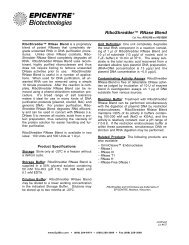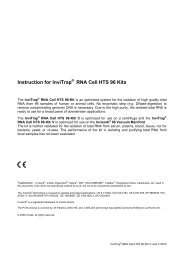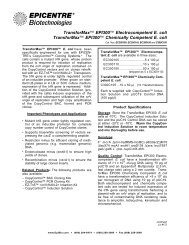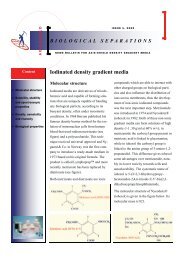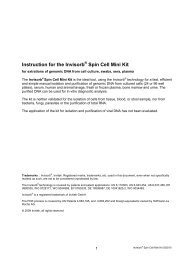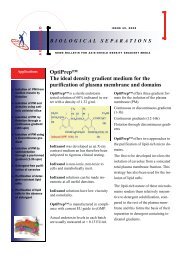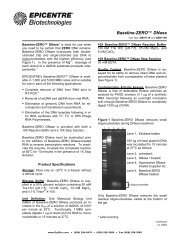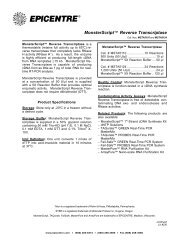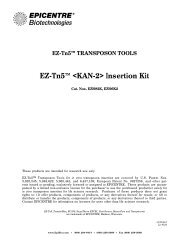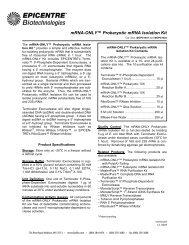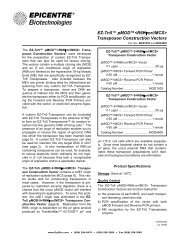Protocol for MasterAmp™ Extra-Long PCR Kit, MasterAmp™ Extra ...
Protocol for MasterAmp™ Extra-Long PCR Kit, MasterAmp™ Extra ...
Protocol for MasterAmp™ Extra-Long PCR Kit, MasterAmp™ Extra ...
- No tags were found...
You also want an ePaper? Increase the reach of your titles
YUMPU automatically turns print PDFs into web optimized ePapers that Google loves.
EPICENTREMasterAmp <strong>Extra</strong>-<strong>Long</strong> <strong>PCR</strong> <strong>Kit</strong>MasterAmp <strong>Extra</strong>-<strong>Long</strong> <strong>PCR</strong> 2X PreMixesMasterAmp <strong>Extra</strong>-<strong>Long</strong> DNA Polymerase MixAmplification of the Control DNA TemplateThe control <strong>PCR</strong> amplification is designed to amplify a 20 kb region of lambda DNA in MasterAmp<strong>Extra</strong>-<strong>Long</strong> <strong>PCR</strong> 2X PreMixes 4 and 6. Users may also observe weak amplification with <strong>Extra</strong>-<strong>Long</strong><strong>PCR</strong> 2X PreMixes 1, 8 and 9.1. Thaw and thoroughly mix all of the reagents be<strong>for</strong>e dispensing. Combine the following at roomtemperature:21 ml sterile water3 ml control template & primers (1 ng DNA and 1 mM each primer, final concentration)1 ml MasterAmp <strong>Extra</strong>-<strong>Long</strong> DNA Polymerase Mix25 ml Total reaction volume2. Aliquot 25 ml of each MasterAmp <strong>Extra</strong>-<strong>Long</strong> <strong>PCR</strong> 2X PreMix into an individual <strong>PCR</strong> tube.3. Add 25 ml of the template-primer-enzyme solution to the <strong>PCR</strong> tubes and mix well.4. Add mineral oil and centrifuge briefly if using a thermal cycler without a heated lid.5. Denature the template at 94 o C <strong>for</strong> 1 minute.6. Per<strong>for</strong>m 20 cycles as follows:Denature at 98 o C <strong>for</strong> 20 seconds.Anneal the primers at 56 o C <strong>for</strong> 1 minute.Extend the annealed primers at 68 o C <strong>for</strong> 20 minutes.7. After amplification, the samples may be kept at 4 o C overnight or frozen at -20 o C.8. Analyze the amplification products by agarose gel electrophoresis.References:1. Barnes, W. M. (1994) Proc. Natl. Acad. Sci. USA 91, 2216.2. Schanke, J. T. and Grunenwald, H. L. (1997) Epicentre Forum 4 (1), 2.3. Grunenwald, H.L. and Schanke, J.T. (1997) Epicentre Forum 4 (1), 4.4. Mytelka, D.S. and Chamberlin, M.J. (1996) Nucl. Acids Res. 24, 2774.5. Henke, W. et al., (1997) Nucl. Acids Res. 25, 3957.6. Weissensteiner, T. and Lanchbury, J.S. (1996) BioTechniques 21, 1102.7. Rees, W.A. et al., (1993) Biochemistry 32, 137.8. Santoro, M.M. et al., (1992) Biochemistry 31, 5278.9. Roux, K.H. (1995) in: <strong>PCR</strong> Primer, Dieffenbach, C.W. and Dveksler, G.S. (eds.), CSH Press, New York, 53.10. Kolmodin, L.A. and Williams, J.F. (1997) in: <strong>PCR</strong> Cloning <strong>Protocol</strong>s, White, B.A. (ed.),Humana Press, Totowa, 6.11. Cha, R.S. and Thilly, W.G. (1995) in: <strong>PCR</strong> Primer, Dieffenbach, C.W. and Dveksler, G.S. (eds.),CSH Press, New York, 37.12. D’Aquila, R.T. et al., (1991) Nucl. Acids Res. 19, 3749.13. Don, R.H. et al., (1991) Nucl. Acids Res. 19, 4008.14. Ohler, L. and Rose, E. A. (1992) <strong>PCR</strong> Methods Appl. 2, 51.15. Cheng, S. (1995) in: <strong>PCR</strong> Strategies, Innis, M. A., Gelfand, D. H, and Sninsky, J. J. (eds.),Academic Press, San Diego, CA, 313.16. Hengen, P. N. (1997) Trends Biochem. Sci. 22, 225.page 4




